
table of contents
- Types from A - D
- Types of E - G
- Types of H - O
- Types of P - R
- Types from S - Z
- frequently asked Questions
In May you can encounter numerous caterpillars preparing for the next phase of their lives. Overall, you can
Encounter 20 species in Central Europe that are often in search of food in the last month of spring.
In a nutshell
- most of the caterpillars are butterfly larvae
- they can be clearly recognized by their size, color and drawing
- final size is only reached after several skins
- each species prefers a specific food source
Types from A - D
Agate owl (Phlogophora meticulosa)
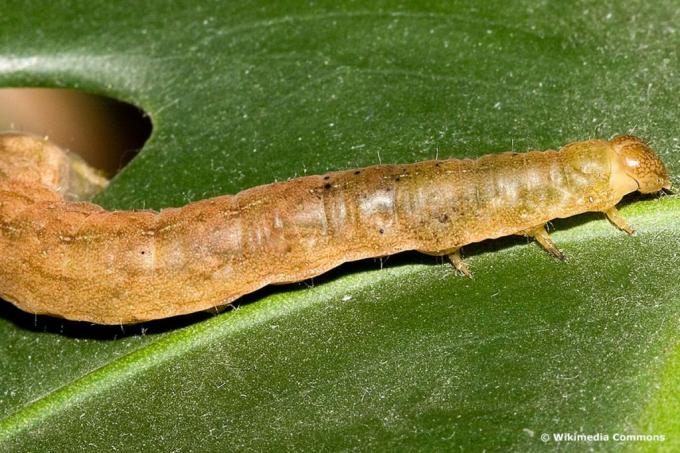
- Synonyms: agate moth, agate owl moth
- Central to Southern Europe, North Africa, Western Asia
- Wet meadows, forest edges, gardens, parks, urban areas
- 40 mm
- red brown (old), green to dark brown (young)
- Back line, on both sides a white spot with a black border
- Nettles, dandelions, blackberry leaves, lettuce
- hatches 3 to 6 weeks after pupation in July
- Pest for ornamental plants, vegetables, fruit trees
Blue head (Diloba caeruleocephala)

- Europe, North Africa, Western Asia
- Orchards, forest edges, bushes, vineyards
- 40 mm
- green, blue, blue-gray, light brown, dark brown, black (depending on the stage)
- Back lines (yellow), dorsal stripes (black), subdorsal bands (yellow), 2 head spots (black), spots on the side and back (yellow)
- Bristles can be seen
- Rose plants (e.g. Apple, cherry or whitebeam trees), oaks, willows
- hatches August
Brown bear (Arctia caja)
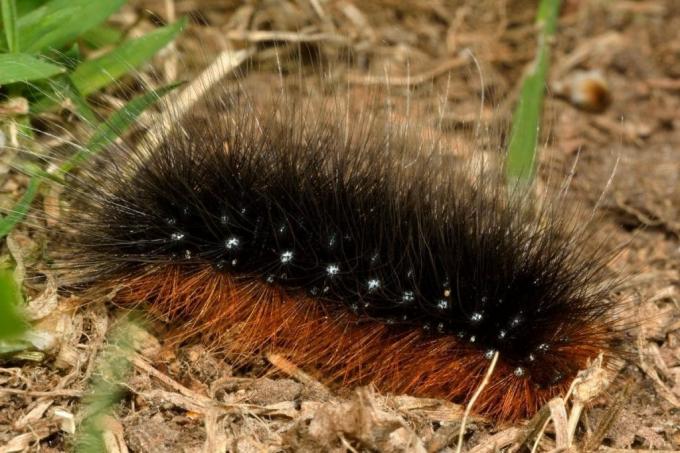
- Europe, Lapland, North America, Asia
- Forest areas (no specialization), meadows, moors, gravel pits, sand pits, urban areas, race
- up to 60 mm
- dark brown, black bristles
- white dotted
- Herbs, shrubs, trees like Raspberries, Blackberries, nettles, willows or oaks
- hatches July
- turns dead in danger
Broad-winged gang owl (Noctua comes)
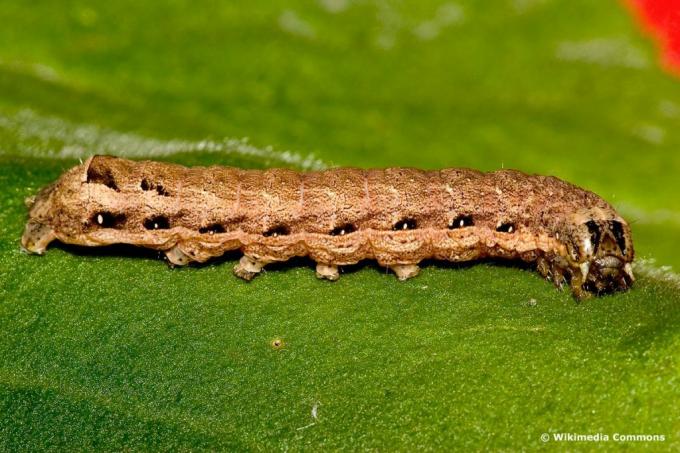
- Synonyms: Leather brown gang owl, primrose owl
- Europe to Scotland and Scandinavian south coasts, North Africa, Western Asia, southern Russia and the Caucasus, North America
- does not make any demands on the living space
- 60 mm
- brown, head in light beige
- light side bands, dark spotted (triangular shape)
- numerous herbs and trees, including lavender, tulips and sour cherries
- hatches June
Types of E - G
Oak processionary moth (Thaumetopoea processionea)

- Southern Europe, Central Europe, Southern Russia, Western Asia
- Oak forests, mixed oak forests, urban areas, parks
- 50 mm
- yellow-brown, gray-blue, black
- dark back stripe
- Oaks, rarely other trees
- hatches in late June to early July
- Oak pest
- Stinging hairs can cause caterpillar dermatitis
- Allergy sufferers should avoid contact
- live in societies with up to 30 copies
- move (processions) in groups
Oak moth (Lasiocampa quercus)
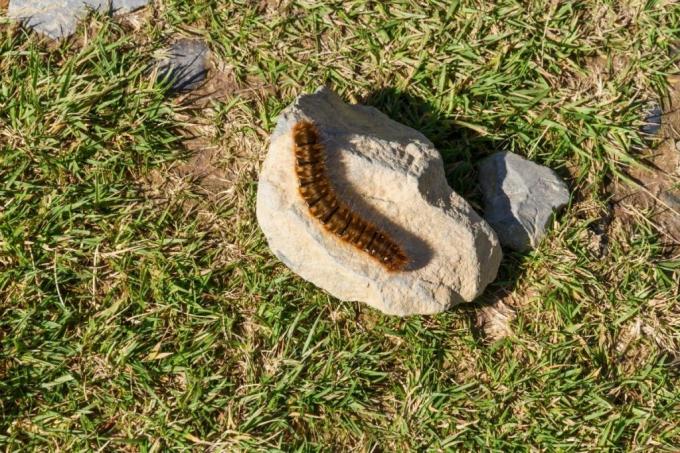
- Synonym: quince bird
- Europe
- light forests, moors, tree lines
- 80 mm
- black to brownish gray
- Diamond on each segment, yellow and brown
- Trees such as blackberries, heather or blueberries, less often on oaks
- hatches at the end of June
- Stinging hairs contain nettle poison
Great frostworm (Erannis defoliaria)

- Northern Europe, Central Europe to Northern Italy and the Balkans
- Deciduous forests, bushes, parks, house gardens
- 32 mm
- yellow-brown, red-brown, black-brown
- Side stripes (yellow) of various thicknesses
- Deciduous trees, including oak, beech, elm, birch, hornbeam, linden
- hatches in late June to mid-July
- is considered a forest pest
Gothica kitten owl (Orthosia gothica)

- Synonyms: gray spring owl, brownish gray spring owl, gothic owl
- Europe, Asia to Japan, the Arctic Circle
- urban areas, cultural landscapes, forest edges, heather, clearings
- 40 mm
- yellow-green
- Dots (yellow), thin side and back lines (white), side stripes (white),
- various trees, including roses, blueberries, nettles, hornbeams
- hatches from mid-July to late August
Big fox (Aglais polychloros)

- Southern Europe, Central Europe (rare), North Africa, Asia Minor, southern Russia to the Caucasus, Urals, Himalayas
- Forest edges, loose forests, parks, orchards, house gardens
- 45 to 50 mm
- dark gray to black
- Tie on the back (orange)
- Thorn outgrowths in orange are present
- various deciduous trees including pears, willows, quivering aspen and cherry trees
- hatches July to August
Types of H - O
Housemother (Noctua pronuba)
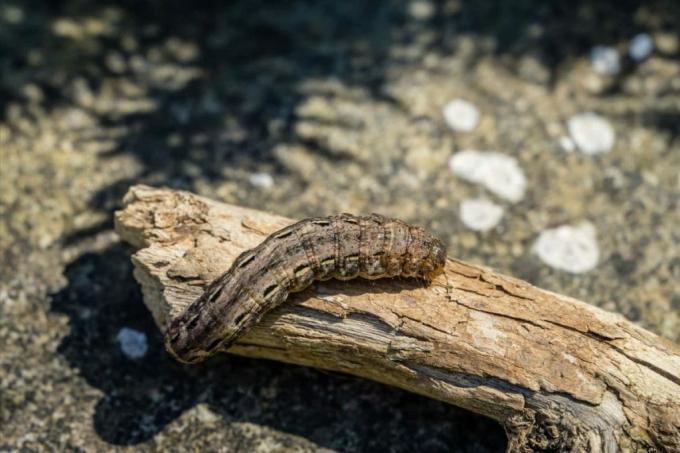
- Europe, Iceland, North Africa, Western Asia to Afghanistan, northwest India, Siberia, North America
- Forests, open terrain
- 60 mm
- yellow-green to brown
- Longitudinal stripes (light brown), dotted with black
- numerous trees and herbs, including rapeseed, cabbage, heather, willow and nettles
- hatches June
Little Fox (Aglais urticae)

- Synonym: nettle butterfly
- Europe to the Atlantic, Asia to the Pacific
- up to 3,000 m altitude
- 30 mm
- black
- Vertical stripes (yellow)
- provided with thorns
- Young caterpillars live together in webs
- only nettle (Urtica dioica)
- hatches in late May to August
Lesser peacock butterfly (Saturnia pavonia)
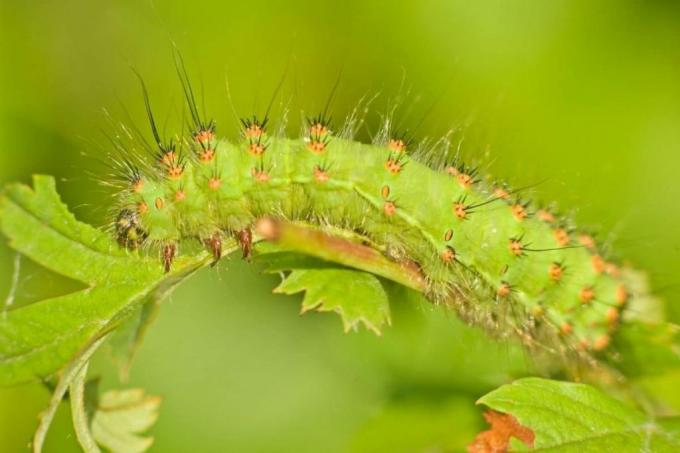
- Europe to Siberia
- Bushes, open terrain, light wooded areas
- 60 mm
- black (young caterpillars), green (adults)
- Spots in young animals (orange), rings in adult caterpillars (black)
- Young animals are hairy
- Warts (yellow, pink) recognizable
- mainly rose trees, including blueberries, blackberries, sloe and apples
- hatches April to May (after the pupae have been overwintered)
Mullein Monk (Cucullia verbasci)

- Brown monk
- Europe with the exception of Northern Europe, Western Asia to Afghanistan, northwestern Africa
- Dry grass, heather, parks, wasteland, rocky slopes
- 50 mm
- white, green-white, yellow-white
- black spots (head), black spots (body), black lines (body), cross bars on each segment (yellow)
- hairy
- mainly mullein, seldom brown sausages
- hatches April to June
Land map (Araschnia levana)
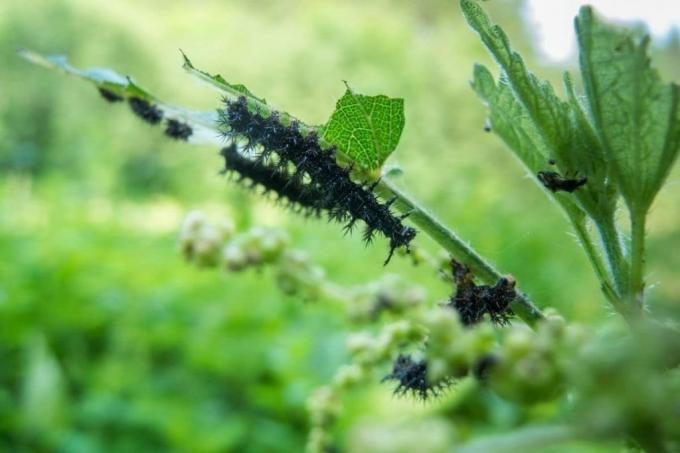
- Synonym: map butterfly
- Northern Spain, Central Europe from the Alps to the coast, Central Asia, Korea, Japan
- Forest edges, open forest areas, intermediate moors, floodplains
- 25 mm
- black
- light brown spotted (side)
- provided with black thorns
- Caterpillars live together in societies
- Nettles
- hatches in mid-April to June or July to August (depending on generation)
Types of P - R
Plum moth (Yponomeuta padella)
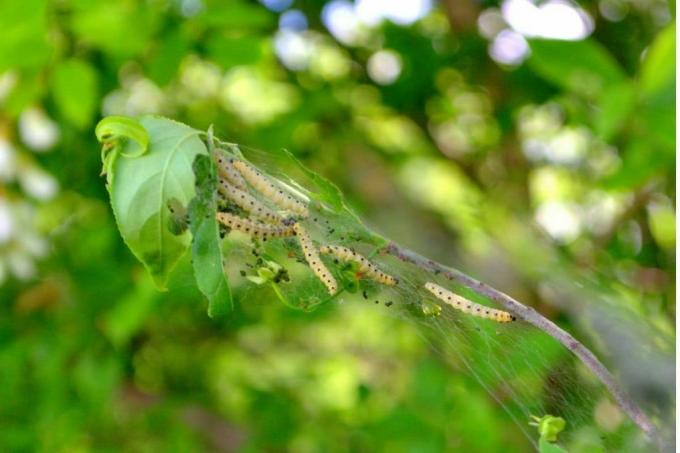
- Europe to Saint Petersburg, southern Caucasus, Central Asia, southern Kazakhstan, North America
- no preference (depending on food plants)
- 15 mm to 25 mm
- green-gray (body), black (head), white (young caterpillars)
- black dotted
- live together in webs
- Cherry, sloe, hawthorn, plum
- hatches June to mid-July
- Culture pest
Pyramid owl (Amphipyra pyramidea)
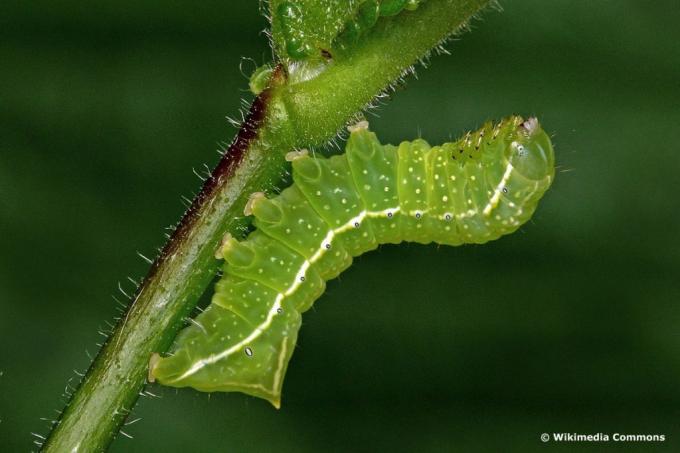
- Europe, Asia (temperate zone)
- Wooded areas, parks, house gardens
- 40 mm to 42 mm
- a pyramidal hump can be seen at the end of the abdomen
- light green
- white dotted, continuous sideline
- Deciduous trees and numerous shrubs, including hazel, wild willow, ash, sycamore maple, raspberry
- hatches at the end of June
Ring moth (Malacosoma neustria)

- Distribution: Europe to the Black Sea, Northern Europe is an exception
- Habitat: orchards, parks, open wooded areas, hedges
- Length: 60mm
- Color: intense blue-gray
- Drawing: back line (white), vertical stripes (yellow, orange, dark shades), head with 2 points (black), resemble eyes
- hairy on the sides
- Food: mainly sloe, other deciduous trees such as pedunculate oaks, pears or apples are not spurned
- Hatching time of the butterfly: late June
- Caterpillar is a bio-indicator for near-natural gardens and meadows
Types from S - Z
Swallowtail (Papilio machaon)

- Europe, Asia to Japan, North Africa
- Fields, house gardens, sunny open landscapes
- 45 mm
- black (young caterpillars), green (adult specimens), rarely white
- Young caterpillars spotted (orange) and with saddle mark (white), adult specimens with horizontal stripes (black) and spots (yellow, orange-red)
- Young caterpillars use mimesis in the form of bird droppings as protection against predators
- indigenous umbelliferae such as carrots, fennel or dill, more rarely on citrus plants
- hatches in mid-April, July, September (depending on generation)
Peacock butterfly (Aglais io)
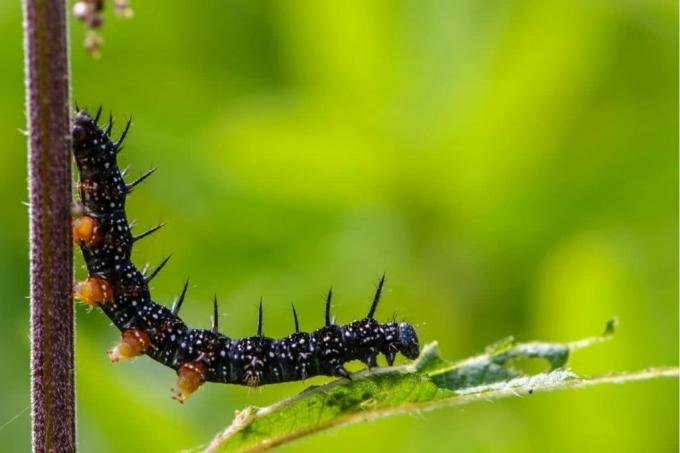
- Central Europe, Asia, Japan
- Open forest, house gardens, parks, up to 2,500 m height
- 40 mm to 42 mm
- black
- white dotted
- provided with thorns
- Caterpillars live together in groups
- Mainly greater nettle, other nettle species and hops are used less often
- hatches June, August (depending on generation)
Hawthorn Owl (Allophyes oxyacanthae)
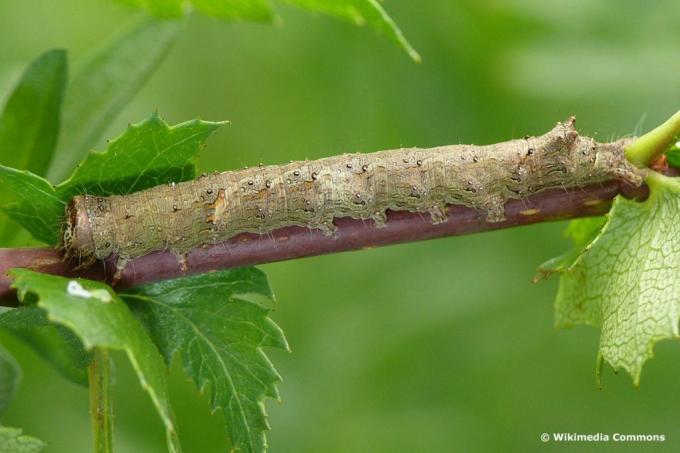
- Europe, exceptions are Iberia, Pyrenees, Mediterranean islands
- Forests, forest edges, clearings
- 60 mm
- light or dark blue-green, brown-gray, light brown (head), light gray (underside)
- dark striped, air holes outlined in black or white, 4 light-colored warts per segment, blue-red striped (underside)
- Hawthorn, apple, sour cherry, dwarf medlars and pears are rarely used as a source of food
- hatches at the end of August
frequently asked Questions
The anal caterpillars are a group of larvae that look very similar to the butterfly caterpillars, but do not belong to them. It is the larvae of the beaked flies (Mecoptera) and saw wasps (Symphyta) that are often pests for a large number of woody plants. The biggest difference is the number of free segments between the belly feet and breastbones. Butterfly caterpillars have two, anal caterpillars only one.
The food they eat is recorded for the caterpillars presented. You have to plant or sow, because the animals mainly eat living plants.
To make your garden butterfly-friendly, you need to provide the insects with a variety of native flowering plants. A bed or a wild corner with wild flowers is sufficient for the beginning, but can be expanded via a barely mowed wild flower meadow. As an alternative, place some flower boxes and butterfly hotels.



